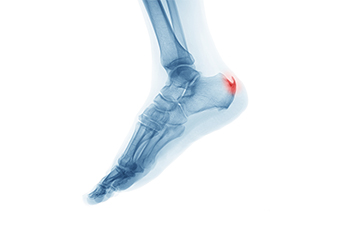 A calcium deposit that forms between the arch of the foot and the heel is referred to as a heel spur. Common symptoms can include heel pain first thing in the morning, followed by a dull ache for the rest of the day. Some patients notice swelling at the front of the heel, and it may feel warm. The heel spur will be visible on an X-ray, and this is a necessary test to have in determining what the proper treatment is. Heel spurs can develop as a result of the aging process when the soft tissue wears thin. People who frequently run may experience this condition, as the heel pad loses shock absorption. Relief may come from elevating the affected foot as often as possible, and this can help to reduce swelling. Additionally, wearing shoes that have a cushion may help to ease the pain that can come from having a heel spur. Many patients who have heel spurs find it is difficult to complete daily activities. If this applies to you or someone you know, it is strongly suggested that you consult with a podiatrist.
A calcium deposit that forms between the arch of the foot and the heel is referred to as a heel spur. Common symptoms can include heel pain first thing in the morning, followed by a dull ache for the rest of the day. Some patients notice swelling at the front of the heel, and it may feel warm. The heel spur will be visible on an X-ray, and this is a necessary test to have in determining what the proper treatment is. Heel spurs can develop as a result of the aging process when the soft tissue wears thin. People who frequently run may experience this condition, as the heel pad loses shock absorption. Relief may come from elevating the affected foot as often as possible, and this can help to reduce swelling. Additionally, wearing shoes that have a cushion may help to ease the pain that can come from having a heel spur. Many patients who have heel spurs find it is difficult to complete daily activities. If this applies to you or someone you know, it is strongly suggested that you consult with a podiatrist.
Heel spurs can be incredibly painful and sometimes may make you unable to participate in physical activities. To get medical care for your heel spurs, contact Dr. Steven Shlonsky from Louisville, Kentucky. Dr. Shlonsky will do everything possible to treat your condition.
Heels Spurs
Heel spurs are formed by calcium deposits on the back of the foot where the heel is. This can also be caused by small fragments of bone breaking off one section of the foot, attaching onto the back of the foot. Heel spurs can also be bone growth on the back of the foot and may grow in the direction of the arch of the foot.
Older individuals usually suffer from heel spurs and pain sometimes intensifies with age. One of the main condition's spurs are related to is plantar fasciitis.
Pain
The pain associated with spurs is often because of weight placed on the feet. When someone is walking, their entire weight is concentrated on the feet. Bone spurs then have the tendency to affect other bones and tissues around the foot. As the pain continues, the feet will become tender and sensitive over time.
Treatments
There are many ways to treat heel spurs. If one is suffering from heel spurs in conjunction with pain, there are several methods for healing. Medication, surgery, and herbal care are some options.
If you have any questions feel free to contact our office located in Louisville, KY . We offer the latest in diagnostic and treatment technology to meet your needs.







